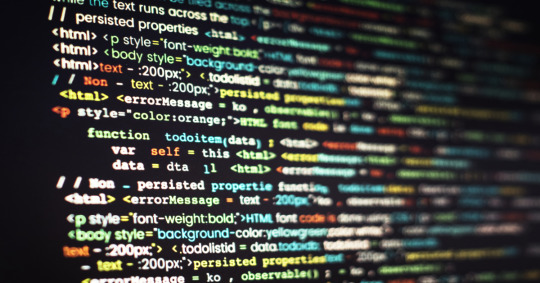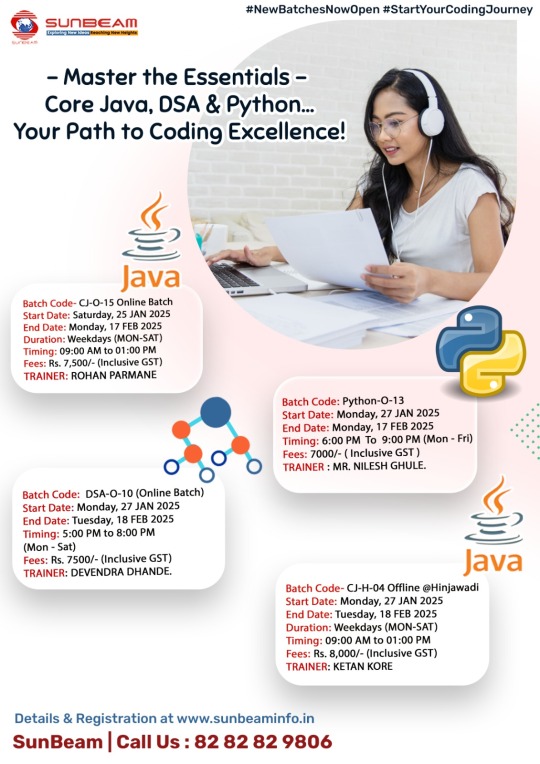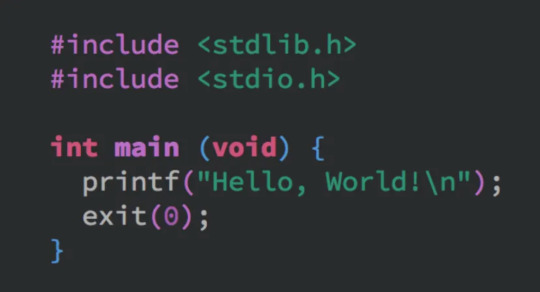#Data Structure in Python
Explore tagged Tumblr posts
Text
What is Data Structure in Python?
Summary: Explore what data structure in Python is, including built-in types like lists, tuples, dictionaries, and sets, as well as advanced structures such as queues and trees. Understanding these can optimize performance and data handling.

Introduction
Data structures are fundamental in programming, organizing and managing data efficiently for optimal performance. Understanding "What is data structure in Python" is crucial for developers to write effective and efficient code. Python, a versatile language, offers a range of built-in and advanced data structures that cater to various needs.
This blog aims to explore the different data structures available in Python, their uses, and how to choose the right one for your tasks. By delving into Python’s data structures, you'll enhance your ability to handle data and solve complex problems effectively.
What are Data Structures?
Data structures are organizational frameworks that enable programmers to store, manage, and retrieve data efficiently. They define the way data is arranged in memory and dictate the operations that can be performed on that data. In essence, data structures are the building blocks of programming that allow you to handle data systematically.
Importance and Role in Organizing Data
Data structures play a critical role in organizing and managing data. By selecting the appropriate data structure, you can optimize performance and efficiency in your applications. For example, using lists allows for dynamic sizing and easy element access, while dictionaries offer quick lookups with key-value pairs.
Data structures also influence the complexity of algorithms, affecting the speed and resource consumption of data processing tasks.
In programming, choosing the right data structure is crucial for solving problems effectively. It directly impacts the efficiency of algorithms, the speed of data retrieval, and the overall performance of your code. Understanding various data structures and their applications helps in writing optimized and scalable programs, making data handling more efficient and effective.
Read: Importance of Python Programming: Real-Time Applications.
Types of Data Structures in Python
Python offers a range of built-in data structures that provide powerful tools for managing and organizing data. These structures are integral to Python programming, each serving unique purposes and offering various functionalities.
Lists
Lists in Python are versatile, ordered collections that can hold items of any data type. Defined using square brackets [], lists support various operations. You can easily add items using the append() method, remove items with remove(), and extract slices with slicing syntax (e.g., list[1:3]). Lists are mutable, allowing changes to their contents after creation.
Tuples
Tuples are similar to lists but immutable. Defined using parentheses (), tuples cannot be altered once created. This immutability makes tuples ideal for storing fixed collections of items, such as coordinates or function arguments. Tuples are often used when data integrity is crucial, and their immutability helps in maintaining consistent data throughout a program.
Dictionaries
Dictionaries store data in key-value pairs, where each key is unique. Defined with curly braces {}, dictionaries provide quick access to values based on their keys. Common operations include retrieving values with the get() method and updating entries using the update() method. Dictionaries are ideal for scenarios requiring fast lookups and efficient data retrieval.
Sets
Sets are unordered collections of unique elements, defined using curly braces {} or the set() function. Sets automatically handle duplicate entries by removing them, which ensures that each element is unique. Key operations include union (combining sets) and intersection (finding common elements). Sets are particularly useful for membership testing and eliminating duplicates from collections.
Each of these data structures has distinct characteristics and use cases, enabling Python developers to select the most appropriate structure based on their needs.
Explore: Pattern Programming in Python: A Beginner’s Guide.
Advanced Data Structures

In advanced programming, choosing the right data structure can significantly impact the performance and efficiency of an application. This section explores some essential advanced data structures in Python, their definitions, use cases, and implementations.
Queues
A queue is a linear data structure that follows the First In, First Out (FIFO) principle. Elements are added at one end (the rear) and removed from the other end (the front).
This makes queues ideal for scenarios where you need to manage tasks in the order they arrive, such as task scheduling or handling requests in a server. In Python, you can implement a queue using collections.deque, which provides an efficient way to append and pop elements from both ends.
Stacks
Stacks operate on the Last In, First Out (LIFO) principle. This means the last element added is the first one to be removed. Stacks are useful for managing function calls, undo mechanisms in applications, and parsing expressions.
In Python, you can implement a stack using a list, with append() and pop() methods to handle elements. Alternatively, collections.deque can also be used for stack operations, offering efficient append and pop operations.
Linked Lists
A linked list is a data structure consisting of nodes, where each node contains a value and a reference (or link) to the next node in the sequence. Linked lists allow for efficient insertions and deletions compared to arrays.
A singly linked list has nodes with a single reference to the next node. Basic operations include traversing the list, inserting new nodes, and deleting existing ones. While Python does not have a built-in linked list implementation, you can create one using custom classes.
Trees
Trees are hierarchical data structures with a root node and child nodes forming a parent-child relationship. They are useful for representing hierarchical data, such as file systems or organizational structures.
Common types include binary trees, where each node has up to two children, and binary search trees, where nodes are arranged in a way that facilitates fast lookups, insertions, and deletions.
Graphs
Graphs consist of nodes (or vertices) connected by edges. They are used to represent relationships between entities, such as social networks or transportation systems. Graphs can be represented using an adjacency matrix or an adjacency list.
The adjacency matrix is a 2D array where each cell indicates the presence or absence of an edge, while the adjacency list maintains a list of edges for each node.
See: Types of Programming Paradigms in Python You Should Know.
Choosing the Right Data Structure
Selecting the appropriate data structure is crucial for optimizing performance and ensuring efficient data management. Each data structure has its strengths and is suited to different scenarios. Here’s how to make the right choice:
Factors to Consider
When choosing a data structure, consider performance, complexity, and specific use cases. Performance involves understanding time and space complexity, which impacts how quickly data can be accessed or modified. For example, lists and tuples offer quick access but differ in mutability.
Tuples are immutable and thus faster for read-only operations, while lists allow for dynamic changes.
Use Cases for Data Structures:
Lists are versatile and ideal for ordered collections of items where frequent updates are needed.
Tuples are perfect for fixed collections of items, providing an immutable structure for data that doesn’t change.
Dictionaries excel in scenarios requiring quick lookups and key-value pairs, making them ideal for managing and retrieving data efficiently.
Sets are used when you need to ensure uniqueness and perform operations like intersections and unions efficiently.
Queues and stacks are used for scenarios needing FIFO (First In, First Out) and LIFO (Last In, First Out) operations, respectively.
Choosing the right data structure based on these factors helps streamline operations and enhance program efficiency.
Check: R Programming vs. Python: A Comparison for Data Science.
Frequently Asked Questions
What is a data structure in Python?
A data structure in Python is an organizational framework that defines how data is stored, managed, and accessed. Python offers built-in structures like lists, tuples, dictionaries, and sets, each serving different purposes and optimizing performance for various tasks.
Why are data structures important in Python?
Data structures are crucial in Python as they impact how efficiently data is managed and accessed. Choosing the right structure, such as lists for dynamic data or dictionaries for fast lookups, directly affects the performance and efficiency of your code.
What are advanced data structures in Python?
Advanced data structures in Python include queues, stacks, linked lists, trees, and graphs. These structures handle complex data management tasks and improve performance for specific operations, such as managing tasks or representing hierarchical relationships.
Conclusion
Understanding "What is data structure in Python" is essential for effective programming. By mastering Python's data structures, from basic lists and dictionaries to advanced queues and trees, developers can optimize data management, enhance performance, and solve complex problems efficiently.
Selecting the appropriate data structure based on your needs will lead to more efficient and scalable code.
#What is Data Structure in Python?#Data Structure in Python#data structures#data structure in python#python#python frameworks#python programming#data science
6 notes
·
View notes
Text
THEYRE MAKING US LEARN JAVA AGAIN
#NOOOOOOOO#okok. apcs was alll about java right. and i thouhg#ok#thats it#were done for#we're gonna move on to like... python#NO#JAVA 2 NOW FEAT. DATA STRUCTURES#PLEASE GIVE ME C++ PLEASE PLEASE PLEA
3 notes
·
View notes
Text
python save me. save me python
#cannot get this fucking lab work to compile so im just gonna focus on my python assignment#because its easy as shit#(although tbf thats almost definitely just because i dont have to modularise or anything)#literally just basic printing and inputting user variables vs using data structures and opening and closing files and pointers and arrays a#afhhhhh#me.txt#maybe ill just take the l on this lab#i can take it. probably
9 notes
·
View notes
Text
Normally I just post about movies but I'm a software engineer by trade so I've got opinions on programming too.
Apparently it's a month of code or something because my dash is filled with people trying to learn Python. And that's great, because Python is a good language with a lot of support and job opportunities. I've just got some scattered thoughts that I thought I'd write down.
Python abstracts a number of useful concepts. It makes it easier to use, but it also means that if you don't understand the concepts then things might go wrong in ways you didn't expect. Memory management and pointer logic is so damn annoying, but you need to understand them. I learned these concepts by learning C++, hopefully there's an easier way these days.
Data structures and algorithms are the bread and butter of any real work (and they're pretty much all that come up in interviews) and they're language agnostic. If you don't know how to traverse a linked list, how to use recursion, what a hash map is for, etc. then you don't really know how to program. You'll pretty much never need to implement any of them from scratch, but you should know when to use them; think of them like building blocks in a Lego set.
Learning a new language is a hell of a lot easier after your first one. Going from Python to Java is mostly just syntax differences. Even "harder" languages like C++ mostly just mean more boilerplate while doing the same things. Learning a new spoken language in is hard, but learning a new programming language is generally closer to learning some new slang or a new accent. Lists in Python are called Vectors in C++, just like how french fries are called chips in London. If you know all the underlying concepts that are common to most programming languages then it's not a huge jump to a new one, at least if you're only doing all the most common stuff. (You will get tripped up by some of the minor differences though. Popping an item off of a stack in Python returns the element, but in Java it returns nothing. You have to read it with Top first. Definitely had a program fail due to that issue).
The above is not true for new paradigms. Python, C++ and Java are all iterative languages. You move to something functional like Haskell and you need a completely different way of thinking. Javascript (not in any way related to Java) has callbacks and I still don't quite have a good handle on them. Hardware languages like VHDL are all synchronous; every line of code in a program runs at the same time! That's a new way of thinking.
Python is stereotyped as a scripting language good only for glue programming or prototypes. It's excellent at those, but I've worked at a number of (successful) startups that all were Python on the backend. Python is robust enough and fast enough to be used for basically anything at this point, except maybe for embedded programming. If you do need the fastest speed possible then you can still drop in some raw C++ for the places you need it (one place I worked at had one very important piece of code in C++ because even milliseconds mattered there, but everything else was Python). The speed differences between Python and C++ are so much smaller these days that you only need them at the scale of the really big companies. It makes sense for Google to use C++ (and they use their own version of it to boot), but any company with less than 100 engineers is probably better off with Python in almost all cases. Honestly thought the best programming language is the one you like, and the one that you're good at.
Design patterns mostly don't matter. They really were only created to make up for language failures of C++; in the original design patterns book 17 of the 23 patterns were just core features of other contemporary languages like LISP. C++ was just really popular while also being kinda bad, so they were necessary. I don't think I've ever once thought about consciously using a design pattern since even before I graduated. Object oriented design is mostly in the same place. You'll use classes because it's a useful way to structure things but multiple inheritance and polymorphism and all the other terms you've learned really don't come into play too often and when they do you use the simplest possible form of them. Code should be simple and easy to understand so make it as simple as possible. As far as inheritance the most I'm willing to do is to have a class with abstract functions (i.e. classes where some functions are empty but are expected to be filled out by the child class) but even then there are usually good alternatives to this.
Related to the above: simple is best. Simple is elegant. If you solve a problem with 4000 lines of code using a bunch of esoteric data structures and language quirks, but someone else did it in 10 then I'll pick the 10. On the other hand a one liner function that requires a lot of unpacking, like a Python function with a bunch of nested lambdas, might be easier to read if you split it up a bit more. Time to read and understand the code is the most important metric, more important than runtime or memory use. You can optimize for the other two later if you have to, but simple has to prevail for the first pass otherwise it's going to be hard for other people to understand. In fact, it'll be hard for you to understand too when you come back to it 3 months later without any context.
Note that I've cut a few things for simplicity. For example: VHDL doesn't quite require every line to run at the same time, but it's still a major paradigm of the language that isn't present in most other languages.
Ok that was a lot to read. I guess I have more to say about programming than I thought. But the core ideas are: Python is pretty good, other languages don't need to be scary, learn your data structures and algorithms and above all keep your code simple and clean.
#programming#python#software engineering#java#java programming#c++#javascript#haskell#VHDL#hardware programming#embedded programming#month of code#design patterns#common lisp#google#data structures#algorithms#hash table#recursion#array#lists#vectors#vector#list#arrays#object oriented programming#functional programming#iterative programming#callbacks
20 notes
·
View notes
Text
Exploring Quantum Leap Sort: A Conceptual Dive into Probabilistic Sorting Created Using AI
In the vast realm of sorting algorithms, where QuickSort, MergeSort, and HeapSort reign supreme, introducing a completely new approach is no small feat. Today, we’ll delve into a purely theoretical concept—Quantum Leap Sort—an imaginative algorithm created using AI that draws inspiration from quantum mechanics and probabilistic computing. While not practical for real-world use, this novel…
#AI#algorithm#amazon#chatgpt#coding#computer science#css#data-structures#DSA#engineering#google#heapsort#insertionsort#javascript#mergesort#new#programming#python#quicksort#radixsort#sorting#tech#tesla#trending#wipro
2 notes
·
View notes
Text

Summer Internship Program 2024
For More Details Visit Our Website - internship.learnandbuild.in
#machine learning#programming#python#linux#data science#data scientist#frontend web development#backend web development#salesforce admin#salesforce development#cloud AI with AWS#Internet of things & AI#Cyber security#Mobile App Development using flutter#data structures & algorithms#java core#python programming#summer internship program#summer internship program 2024
2 notes
·
View notes
Text
How to Start Your Journey in Computer Science

Introduction
Computer Science is one of the most dynamic and in-demand fields today. From mobile apps to AI, data analysis to cybersecurity, the scope of computer science is vast. For students wondering where to begin, the journey starts with building strong fundamentals.
Whether you're a school student or a graduate exploring your career options, learning core programming languages, data handling, and software skills is the first step. If you’re located in areas like Yamuna Vihar or Uttam Nagar, you’ll find a wide range of structured learning options available to get started on the right path.
1. Begin with Programming Fundamentals
The foundation of computer science begins with learning programming languages. Languages like C and C++ are ideal for beginners as they help build logic and understanding of how a computer processes instructions. Many students begin with:
C Classes or C++ Classes
C++ Coaching Instituteor nearby areas
These help you master the syntax, data types, control structures, and problem-solving skills necessary for advanced learning.
2. Advance to Object-Oriented Programming (OOP)
Once you’re comfortable with the basics, moving on to C++ and Java is a smart move. These object-oriented languages teach you how to write reusable code and develop software systematically.
Students often opt for:
C++ Training or Java Training
Java Coaching Institute for deeper concept clarity
Java Classes for hands-on project experience
These courses prepare you for real-world applications and interviews in software roles.
3. Strengthen Your Data Structure Knowledge
Knowing how to write code is just the beginning. Efficient coding depends on how well you understand Data Structures. This includes arrays, linked lists, stacks, queues, trees, and graphs.
If you're planning to enter software development, software engineering, or competitive programming, joining a good Data Structure Course in or a Data Structure Training Institute is essential.
You can also explore:
Data Structure Coaching Institute in Yamuna Vihar
Data Structure Classeswith live problem-solving sessions
4. Learn About Databases and Query Languages
Another important area is managing and retrieving data. SQL and MySQL are used in almost every application that stores data—from websites to mobile apps. Learning how to interact with databases gives you an edge.
You can begin with:
SQL Classes or SQL Classes
MySQL Training Institute or MySQL
Practical exposure through MySQL Coaching Institute or MySQL Coaching helps in writing efficient queries and understanding database management.
5. Explore Specializations like Web & App Development
Once you’re comfortable with basic coding and data handling, you can start exploring more specific fields. Web technologies like HTML, CSS, JavaScript, JSP, and frameworks like React or Angular are a great way to enter front-end or back-end development.
You’ll find JSP Coaching and JSP Coaching in Uttam Nagar useful if you're interested in Java-based web development.
6. Build a Strong Foundation with Computer Applications
If you’re starting from scratch or want a general overview, Diploma in Computer Application (DCA) and Advanced Diploma in Computer Application (ADCA) are valuable. They cover basic software tools, internet usage, data handling, and more.
Many students choose:
DCA Course or DCA Course
Advanced Diploma in Computer Application for deeper learning
Computer Application Coaching Institute for practical training
7. Practice and Build Projects
Learning theory is not enough. Building real-time projects—like calculators, mini games, websites, or management systems—helps you apply your knowledge and showcase your skills to future employers.
Join local Computer Science Training Institutes in Uttam nagar that focus on project-based learning. Hands-on experience not only strengthens your understanding but also boosts your confidence.
Final Thoughts
The journey into computer science is not a sprint—it's a step-by-step learning experience. Whether you’re looking for C++ Coaching , Data Structure Coaching, or even Computer Science Course, the key is to start with the basics and grow gradually.
Choose courses that focus on real-world applications, give you coding practice, and help you understand concepts deeply. The demand for skilled programmers, software developers, and data analysts is only growing. Now is the right time to begin your journey.
Suggested Links:
C++ Programming Language
Database Management System
Advanced Data Structures
Learn Core Java
#computer science course#computer science training#database management system#java training#C++ programming language course#advance Data structures course#python course in yamuna vihar#python course in uttam nagar
0 notes
Text
Bubble Sort in Python
Bubble Sort is a basic comparison-based sorting algorithm that works by repeatedly swapping adjacent elements if they are in the wrong order. The largest values “bubble up” to the end of the list with each pass, gradually sorting the entire list. Although it's easy to understand and code especially in Python using loops Bubble Sort is not efficient for large datasets due to its O(n²) time complexity.
However, an optimized version includes a flag to check if any swaps occurred in a pass, allowing early termination when the list becomes sorted. This makes it a valuable learning tool in data structures and algorithms, despite not being suitable for performance-critical applications.

Bubble Sort is ideal for beginners to grasp the fundamentals of sorting logic and iterative operations.
Its practical use is limited algorithms like Merge Sort or Quick Sort are better suited for real-world problems.
Enhance your understanding of sorting algorithms and Python programming with PrepInsta’s expertly curated DSA course built to make coding interviews simpler and smarter. Check out the full guide here: PrepInsta – Bubble Sort in Python
1 note
·
View note
Text
Data Structures in Popular Programming Languages: A Top Down Introduction
Data structures are fundamental building blocks in programming, allowing developers to efficiently store, organize, and manipulate data. Every programming language provides built-in data structures, and developers can also create custom ones to suit specific needs. Below, we will explore: What data structures are and why they are important Common data structures in programming How to…
#application-developement#c-sharp#c++#data-structures#embedded-development#learn-application-development#learning-experiments-in-coding#lists#mobile-development#php#programming#python#software-developement#software-development#tables#web-development
0 notes
Text

Elevate your IT expertise with Sunbeam Institute's comprehensive modular courses in Pune. Designed for both budding professionals and seasoned experts, our programs offer in-depth knowledge and practical skills to excel in today's dynamic tech industry.
Course Offerings:
Advance Java with Spring Hibernate
Duration: 90 hours
Overview: Master advanced Java programming and integrate with Spring and Hibernate frameworks for robust enterprise applications.
Python Development
Duration: 40 hours
Overview: Gain proficiency in Python programming, covering fundamental to advanced topics for versatile application development.
Data Structures and Algorithms
Duration: 60 hours
Overview: Understand and implement essential data structures and algorithms to optimize problem-solving skills.
DevOps
Duration: 80 hours
Overview: Learn the principles and tools of DevOps to streamline software development and deployment processes.
Machine Learning
Duration: 40 hours
Overview: Delve into machine learning concepts and applications, preparing you for the evolving AI landscape.
Why Choose Sunbeam Institute?
Experienced Faculty: Learn from industry experts with extensive teaching and real-world experience.
Hands-on Training: Engage in practical sessions and projects to apply theoretical knowledge effectively.
State-of-the-Art Infrastructure: Benefit from modern labs and resources that foster an optimal learning environment.
Placement Assistance: Leverage our strong industry connections to secure promising career opportunities.
#python course in pune#advanced python classes pune#c programming#core java course#devops classes in pune#data structures algorithms
0 notes
Text
Top bca,bsc,data science colleges bhubaneswar
Lakshya Institute of Technology, Bhubaneswar offers excellent placement support in leading IT companies for BCA, BSc ITM, BSc CS and BSc Data Science.
#top bca#bsc#data science colleges bhubaneswar#bca#bsc ITM#C#JAVA#PYTHON#ORACLE institute in Bhubaneswar#Best Bsc ITM(H) course college in Bhubaneswar#Best Bsc ITM Honours course college in Bhubaneswar#Top college for Bsc data science in Bhubaneswar#top bca colleges bhubaneswar#top bsc colleges bhubaneswar#DOTNET in bhubaneswar#php course in bhubaneswar#autocad course in bhubaneswar#data structure course bbsr#Best c++ course bhubaneswar#core java course in bhubaneswar#matlab courses in bhubaneswar#spoken English classes in Bhubaneswar#PGDCA course in bhubaneswar#AI/ML courses in bhubaneswar#Artificial intelligence courses in bhubaneswar
0 notes
Text
Getting Started with Python: A Beginner's Guide (pt 2)
They say teaching is the best way to learn. Consider subscribing to the website!
Expanding Your Knowledge: Collections and Control Flow In Part 1 of our beginner’s guide to Python, we covered the basics of variables, data types, and conditional statements. Now, let’s dive deeper into collections like lists, tuples, and dictionaries, as well as control flow mechanisms such as loops and functions. Lists: More Than Just Arrays As mentioned earlier, a list is a collection of…
#Beginner#Coding#Dictionaries#Functions#Getting started with Python#Introduction to Python programming#Learn Python#Lists#Loops#Programming#Python#Python basics#Python conditional statements#Python control structures#Python data types#Python for beginners#Python operators#Python variables#Tuples
0 notes
Text
"Mastering C Programming: A Comprehensive Guide for Beginners and Experts"
Understanding C Programming: The Foundation of Modern Software Development
C programming, developed in the early 1970s by Dennis Ritchie at Bell Labs, is one of the most enduring and influential programming languages in the history of computing. Its design has directly influenced many other popular languages such as C++, Java, and Python. Despite the emergence of numerous high-level programming languages, C remains a cornerstone in both academic and professional software development environments due to its efficiency, control, and widespread use in system-level programming.

The Essence of C Programming
C is a general-purpose programming language that is particularly well-suited for system programming, including the development of operating systems, compilers, and embedded systems. It provides low-level access to memory through the use of pointers, which allows for efficient manipulation of data and memory management. This is one reason why the UNIX operating system, originally written in assembly language, was eventually rewritten in C.
The syntax of C is concise and powerful. Its constructs map efficiently to typical machine instructions, which makes it an ideal language for performance-critical applications. The simplicity of C's syntax, compared to other languages at the time of its creation, made it easier to learn and use while still being robust enough to handle complex programming tasks.
Key Features of C
Portability: One of the primary reasons for C's enduring popularity is its portability. Programs written in C can be compiled and run on different types of computers with little or no modification, which is crucial in today's diverse computing environments.
Efficiency: C is known for producing fast and efficient code. Its low-level capabilities allow programmers to write code that executes quickly and uses system resources judiciously. This makes it an excellent choice for performance-sensitive applications.
Modularity: C encourages the modular design of software. Functions in C can be defined and called independently, which makes code easier to understand, maintain, and reuse. This modularity is further enhanced by the use of header files and libraries.
Rich Library Support: The standard C library provides a rich set of built-in functions for performing common tasks, such as input/output operations, string manipulation, mathematical computations, and memory management. This extensive library support accelerates the development process.
C in Modern Context
Despite being over four decades old, C remains relevant in modern computing. It is extensively used in developing firmware and embedded systems, where direct hardware manipulation is required. The language's influence is also evident in many contemporary programming languages. For example, C++ was developed as an extension of C to include object-oriented features while maintaining C's efficiency and low-level capabilities.
Learning C provides a strong foundation for understanding computer science concepts and principles. Many educational institutions use C as an introductory programming language because it teaches fundamental programming techniques, such as variable manipulation, control structures, data structures, and algorithm development, which are applicable to learning other languages.
Conclusion
C programming is more than just a language; it is a gateway to understanding the inner workings of computers and software development. Its efficiency, control, portability, and rich library support make it an indispensable tool for programmers. Whether used in system programming, embedded systems, or as a stepping stone to other languages, C continues to be a fundamental part of the software development landscape. Its influence on modern programming practices and its role in the development of many other languages underscore its importance and enduring legacy in the world of computing.
1 note
·
View note
Text
Get this Programming Languages Mega Software Bundle!
Get this Programming Languages Mega Software Bundle! #sale #coding #programming #education #learning #javascript #python #datastructures #algorithms #git
This bundle of 20+ coding items covers JS, Python, Git, and other critical topics! Use this link to check out the three bundle options with up to 26 items. Looking to build a reference library that’ll cover a wide spectrum of essential programming languages and technologies? This bundle from Packt has you covered. Bone up on the foundational language of web development with Modern JavaScript…

View On WordPress
#C++#data structures#developer#education#git#humble bundle#javascript#js#node.js#programmer#programming#python
0 notes
Text

Learn and Build Summer Internship Program
For more details visit - Internship.learnandbuild.in
#data structures & algorithms#Java Core#Python Programming#Frontend web development#Backend web development#data science#machine learning & AI#Salesforce Admin#Salesforce Development#Cloud AI with AWS#Internet of things & AI#Cyber Security#Mobile app development using flutter
0 notes
Text
Best Computer Training Institute In Dwarka | ESS Institute
ESS Institute in Dwarka provides training on all computer courses like hardware, networking, programming languages & Basic Computer Course
#Best Computer Training Institute In Dwarka#python training#ADCA course#programming#marketing#data structures#accounting
1 note
·
View note